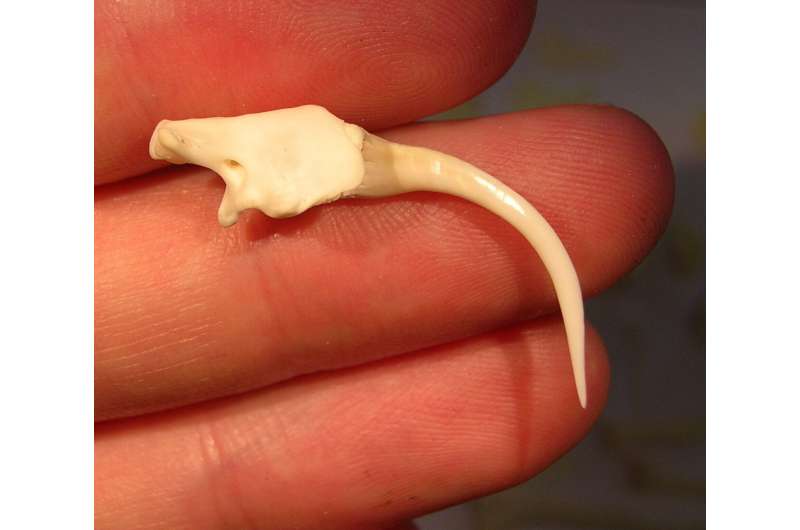
Types of venom fangs in snakes: Rear fangs (crab-eating water snake), fixed front fangs (taipan), and hinged front fangs (Gaboon viper); fangs highlighted in red
Posted on 08/11/2021 8:51:35 AM PDT by LibWhacker

Types of venom fangs in snakes: Rear fangs (crab-eating water snake), fixed front fangs (taipan), and hinged front fangs (Gaboon viper); fangs highlighted in red
Ever wondered how deadly snakes evolved their fangs? The answer lies in particular microscopic features of their teeth, research led by Flinders University and the South Australian Museum suggests.
"It's always been a mystery why fangs have evolved so many times in snakes, but rarely in other reptiles. Our study answers this, showing how easy it is for normal snake teeth to turn into hypodermic needles," says lead author Dr. Alessandro Palci, from Flinders University.
Of almost 4,000 species of snakes alive today, about 600 of them are considered "medically significant" to humans, meaning that if you get bitten you are very likely to require a visit to the nearest hospital for treatment.

The fang of a Gaboon viper (attached to the bone, the maxilla). Credit: A.Palci, Flinders University
Venom fangs are modified teeth that are grooved and larger than other nearby teeth. They can be located at the back or at the front of the mouth, where they can be fixed or hinged (i.e. they can fold backwards).
Australian and overseas researchers used high-tech modeling, fossils, and hours of microscope observations to reveal that snakes possess tiny infoldings, or wrinkles, at the base of the teeth. These infoldings might help teeth attach more firmly to the jaw. In venomous snakes, one of these wrinkles becomes deeper and extends all the way to the tooth tip, thus producing a venom groove and a fang.

Skull of a taipan and sections through its left fang showing the relationship between venom groove and infoldings at the base of the tooth
"Our work also highlights the opportunism and efficiency of evolution. Wrinkles which helped attach teeth to the jaw were repurposed to help inject venom," says co-author Professor Michael Lee (Flinders University and South Australian Museum).
God is THE Great Engineer.........................

by Rudyard Kipling.
Good theory on how snakes might have evolved a hollow tooth.
To me, however, the bigger mystery is how a snake would develop a venom sack coupled to the hollow tooth containing poison harmless to the snake but deadly to prey.


Eels interbred with tax collectors. I thought everybody knew this.
But Who repurposed the wrinkle in the teeth, I wonder?
Just as strange as how snakes developed fangs, one night in the 1970’s, some kid broke into the Reptile House at National Zoo in Washington D.C. He managed to steal a full sized Gabon Viper - which is a very impressive snake. He put it into a paper grocery bag, and while riding home on a city bus, the snake bit him. He survived, but only because they rushed in anti-venom in from somewhere else.
If they had a Gabon Viper in the zoo, then the antivenin was near at hand..................
Yes a paper grocery bag should do…. Yes.
https://www.nytimes.com/1983/04/06/us/zoos-come-to-aid-of-teen-ager-bitten-by-viper-stolen-from-cage-in-washington.html
It doesnt say they are hollow like a needle, it says and shows in the diagram cross sections that it has a deep groove on the back side as the fang penetrates , which keeps the venom from being wiped off.
Which was my understanding before, snake fangs are not really like hypodermic needles.
You know what, you are right, that last cross section is halfway down and is like a hypodermic. mea culpa.
Genesis 49:17
Dan shall be a serpent by the way, an adder in the path, that biteth the horse heels, so that his rider shall fall backward.
Genesis 49:17
Dan shall be a serpent by the way, an adder in the path, that biteth the horse heels, so that his rider shall fall backward.
thank you - now I have to clean up coffee from my desk
Only I heard it was lawyers
Disclaimer: Opinions posted on Free Republic are those of the individual posters and do not necessarily represent the opinion of Free Republic or its management. All materials posted herein are protected by copyright law and the exemption for fair use of copyrighted works.